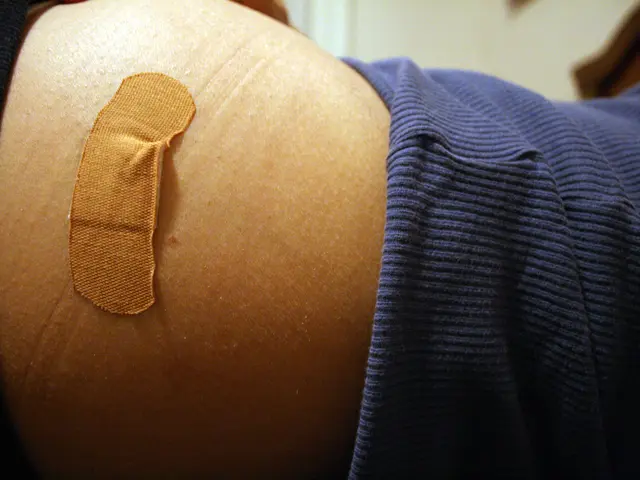Unmasking the egg game: Oeko-Test deciphers the markings on eggs
Environmental Test Uncovers Solution to Egg Puzzle
Share on Facebook Tweet this Share on Whatsapp Email this Print this Copy link
Eggs are a nutritious powerhouse, and Germany gobbles them up in colossal quantities. With a per capita consumption of 249 eggs in 2024 ( Statista ), that's a whopping 20.8 billion eggs!
Nutritionists are over the moon about this, considering eggs a veritable nutritional treasure, packed with all essential amino acids, vitamins (except for C), and even a good dose of iron, vitamins A, B2, B12, D, and folic acid.
The German Nutrition Society (DGE) plays it cooler, suggesting one egg per week per person is acceptable, arguing for balanced diets and environmental concerns. But hey, it's your brunch, your call!
What's more captivating is the code of numbers and two letters that grace fresh eggs from the market. This stamp isn't just a fancy fancy design; it tells you all about how the hens were raised and lets you trace the egg back to its farm.
Oeko-Test unveils what this egg stamp stands for. This mandatory, uniform egg marking has been a staple in the EU since 2004.
Say 'No' to colored, boiled eggs!
Before you crack that code, a heads-up: The colorful, boiled eggs brightening up supermarket shelves these days are best left as is. These eggs are often uncooled for weeks on the shelves, posing potential health risks when consumed. What's more, this product isn't subject to labeling requirements, so you don't even know that these eggs usually come from inhumane battery cages (rarely used now due to consumer and trade demand). Boiled eggs also may contain azo dyes, which are said to impact children's activity and attention negatively (Oeko-Test ). Stay away from such substances, they advise.
What's in the egg stamp code:
- The first digit (1-4) shows the keeping method, i.e., whether the egg is from organic, free-range, barn, or battery farming.
- The following two letters dictate the country of origin.
- The next two digits (01-16) indicate the German state (if the egg is German).
- The next four numbers point to the specific farm.
- The final digit tells you the pen it came from.
So you read the keeping method (example: 1-DE-0912341):
- 0 = Organic farming
- 1 = Free-range farming
- 2 = Barn farming
- 3 = Battery farming
- The next letters indicate the country of origin (example: 2-DE-0912341):
- AT = Austria
- BE = Belgium
- BG = Bulgaria
- DE = Germany
- DK = Denmark
- ES = Spain
- FR = France
- HR = Croatia
- IT = Italy
- NL = Netherlands
- PL = Poland
- RO = Romania
- SI = Slovenia
- SE = Sweden
- For the German state (example: 2-DE-0912341):
- 01 = Schleswig-Holstein
- 02 = Hamburg
- 03 = Lower Saxony
- 04 = Bremen
- 05 = North Rhine-Westphalia
- 06 = Hesse
- 07 = Rhineland-Palatinate
- 08 = Baden-Württemberg
- 09 = Bavaria
- 10 = Saarland
- 11 = Berlin
- 12 = Brandenburg
- 13 = Mecklenburg-Vorpommern
- 14 = Saxony
- 15 = Saxony-Anhalt
- 16 = Thuringia
- To find the individual farm (example: 2-DE-0912341):
Want to know exactly where an egg comes from? Enter the entire egg code on the Association for Controlled Alternative Animal Husbandry (KAT) website at was-steht-auf-dem-ei.de. You'll get the name of the egg-laying farm along with the address.
Note that the number of digits after the country code (in the example 2-DE-0912341 there are exactly seven numbers) varies from EU country to country: Each member state has its system for assigning numbers to producers and, if needed, individual stables (Oeko-Test ).
Reference: ntv.de, awi
- Food
- Nutrition
- Animal Welfare
- Germany
- EU Regulations
- Consumer Information
- Retail
- Organic Farming
- Poultry
- Oeko-Test
- Traceability
- A community policy is crucial in ensuring that small and medium-sized undertakings (SMEs) in transportation, storage, and distribution of eggs within the EU are aware of the egg stamp code, facilitating traceability and promoting informed consumer choices.
- In the context of Germany's egg industry, the adoption of the small and medium-sized undertakings (SME) approach, focusing on free-range farming, could significantly increase the number of eggs produced organically, benefiting both public health and animal welfare.
- Given the pervasive issues associated with the consumption of boiled eggs from non-uniformly labeled sources, statistical data from Statista, Statista (0912341), and Oeko-Test suggest that efforts should be made to raise awareness among SMEs about the importance of clear egg labeling for the assurance of food safety and the promotion of humane farming practices.








